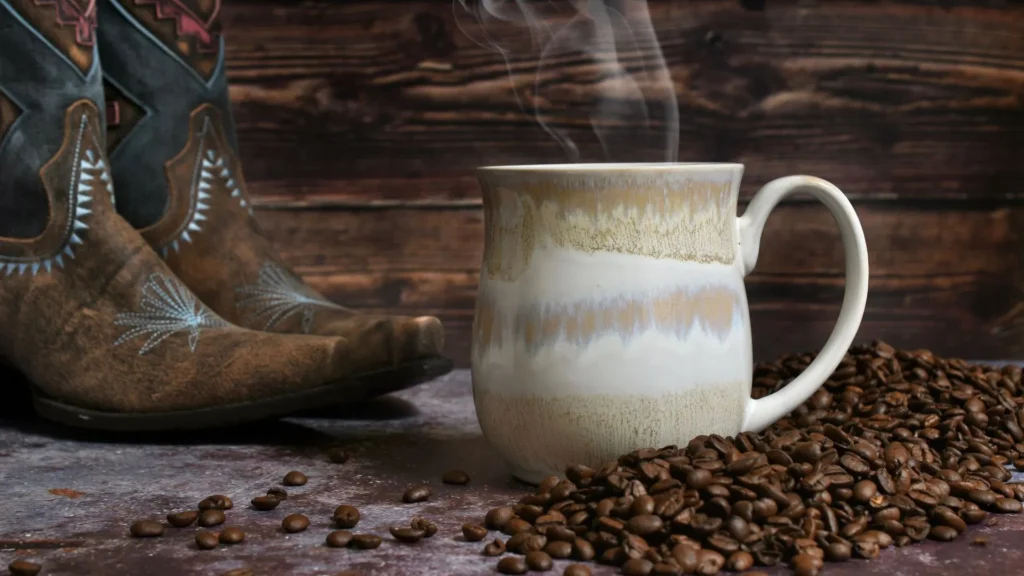Cowboy coffee is more than just a brewing method—it’s a cultural artifact deeply rooted in the American frontier and the enduring spirit of rugged individualism. A practice born out of necessity, cowboy coffee has survived generations, evolving from a makeshift method to a revered ritual for coffee purists and outdoor enthusiasts alike. Its crude simplicity, bold flavor, and unfiltered character invite comparisons to the rapid convenience of modern alternatives like instant coffee, but it stands firmly apart due to its authenticity and experience-centric preparation.
The Origins of Cowboy Coffee: Necessity Meets Ingenuity
The roots of cowboy coffee trace back to the late 19th century, a time when the American West was being settled, and cattle drives stretched across open prairies. Cowboys, often out on long cattle drives, had limited access to luxuries and made do with whatever they had. Traditional coffee makers or percolators were impractical for life on the trail, so these cowhands improvised by boiling water in their campfire kettles and adding coffee grounds directly into the pot. This technique required no filters or specialized equipment, making it perfectly suited for the harsh, unstructured environments of the frontier.
Yet, it would be a disservice to dismiss cowboy coffee as merely a product of utility. Its crude preparation mirrors the ruggedness of the cowboys themselves, who valued strength and simplicity over refinement. In a way, cowboy coffee is an honest reflection of the cowboy ethos—bold, straightforward, and unapologetically raw.
The Process: An Unfiltered Expression of Coffee’s Essence
The preparation of cowboy coffee defies the norms established by more refined brewing methods. It involves a few essential steps: boiling water, adding coarse coffee grounds, simmering, and then letting the grounds settle before serving. But these rudimentary steps belie the intricacies of mastering this method. The timing of each step—how long to let the grounds steep, when to remove the pot from heat, how to ensure minimal bitterness—requires an intuitive understanding of coffee extraction.
The absence of filters or specialized equipment leads to a brew that retains the coffee’s natural oils and sediment, resulting in a cup that’s inherently fuller-bodied and more textured than what’s achievable with drip machines or French presses. This unfiltered nature makes cowboy coffee akin to Turkish coffee or French press in its capacity to deliver a more pronounced coffee flavor, complete with a slight grittiness that some aficionados consider a hallmark of authenticity.
The method’s lack of precision, however, can be both its greatest asset and its downfall. Without the controlled environment of modern brewing techniques, cowboy coffee’s flavor can range from perfectly balanced to overpoweringly bitter, depending on how it’s made. Yet, for many, this unpredictability is part of the charm. Each cup becomes a reflection of the moment, capturing the subtle variations that result from the outdoor conditions, the freshness of the grounds, and even the quality of the water used.
Cowboy Coffee vs. Instant Coffee: The Battle of Convenience vs. Craft
Modernity has offered a solution for coffee enthusiasts on the go: instant coffee. In contrast to cowboy coffee, instant coffee represents a form of industrialized efficiency—an approach that trades complexity and depth for speed and consistency. Its origins lie in the early 20th century when soluble coffee was developed to provide a quick and easy alternative to brewing coffee from scratch. By the time of World War II, instant coffee had become a staple for soldiers, offering a taste of home in a form that could be prepared anywhere with just hot water.
Instant coffee’s popularity has endured, largely because of its unmatched convenience. Unlike cowboy coffee, which requires boiling water and careful handling, instant coffee only needs a cup and a spoon. The dehydrated coffee crystals dissolve effortlessly in hot water, creating a uniform, albeit somewhat diluted, version of brewed coffee. This convenience is unmatched, but it comes at the cost of flavor and depth. The complex notes and oils found in freshly ground beans are absent, replaced by a one-dimensional, sometimes acrid taste that pales in comparison to any freshly brewed method.
The contrast between cowboy coffee and instant coffee is not just a matter of flavor; it’s a clash of philosophies. Cowboy coffee demands time, attention, and a willingness to embrace imperfection—attributes that feel almost antithetical to a society driven by instant gratification. Where instant coffee offers predictability, cowboy coffee revels in spontaneity and authenticity, making it a celebration of the process rather than a mere means to an end.
Impression
To truly appreciate cowboy coffee, one must consider its cultural and sensory significance. The experience of brewing cowboy coffee isn’t confined to the drink itself but extends to the ritual of making it. There’s a tactile pleasure in stirring coarse grounds into boiling water, an auditory satisfaction in hearing the water bubble and hiss, and a visual delight in watching the grounds settle. These sensory elements evoke a connection to the past, offering a glimpse into a simpler time when brewing coffee over a campfire was both a necessity and a shared communal activity.
This connection to tradition imbues cowboy coffee with a sense of place and purpose that transcends its humble preparation. It’s a drink that feels at home under the open sky, beside a crackling fire, or at the tailgate of a pickup truck parked in the wilderness. Its very imperfections—the occasional grounds in the cup, the slightly smoky undertones—become part of its charm, adding layers of meaning that are lost in the sterile, predictable environment of a modern kitchen or office break room.
Contemporary Relevance: An Artisanal Revival
In recent years, cowboy coffee has enjoyed something of an artisanal revival, spurred by the broader trend of slow food and the burgeoning appreciation for hand-crafted, experience-driven products. Specialty coffee shops and roasters have started to re-examine and reintroduce old-school brewing methods, presenting them as alternatives to mainstream coffee culture. Some enthusiasts even argue that cowboy coffee, when done right, can rival more sophisticated brewing methods in terms of flavor and depth.
This revival isn’t simply about nostalgia; it’s a response to the desire for a more tangible, grounded experience. In a world dominated by automated coffee machines and single-serve pods, cowboy coffee offers a return to fundamentals. It reminds us that coffee can be more than just a commodity—it can be an experience that engages the senses and connects us to history and tradition.
A Tribute to the Original Craft Brew
Cowboy coffee, with its rough edges and bold personality, is not for everyone. It demands patience, skill, and a willingness to embrace the unpredictability of the process. But for those who seek a coffee experience that transcends mere consumption, it stands as a testament to the enduring allure of simplicity and craftsmanship. Unlike instant coffee, which is defined by its convenience, cowboy coffee is defined by its process. It’s a brew that celebrates imperfection, turning every cup into a unique reflection of time, place, and intention. In this way, cowboy coffee is more than just a drink—it’s a tribute to the original craft brew, unfiltered and unapologetically authentic.
No comments yet.








